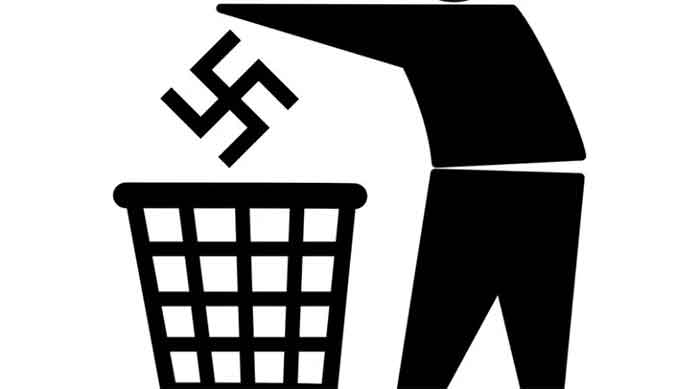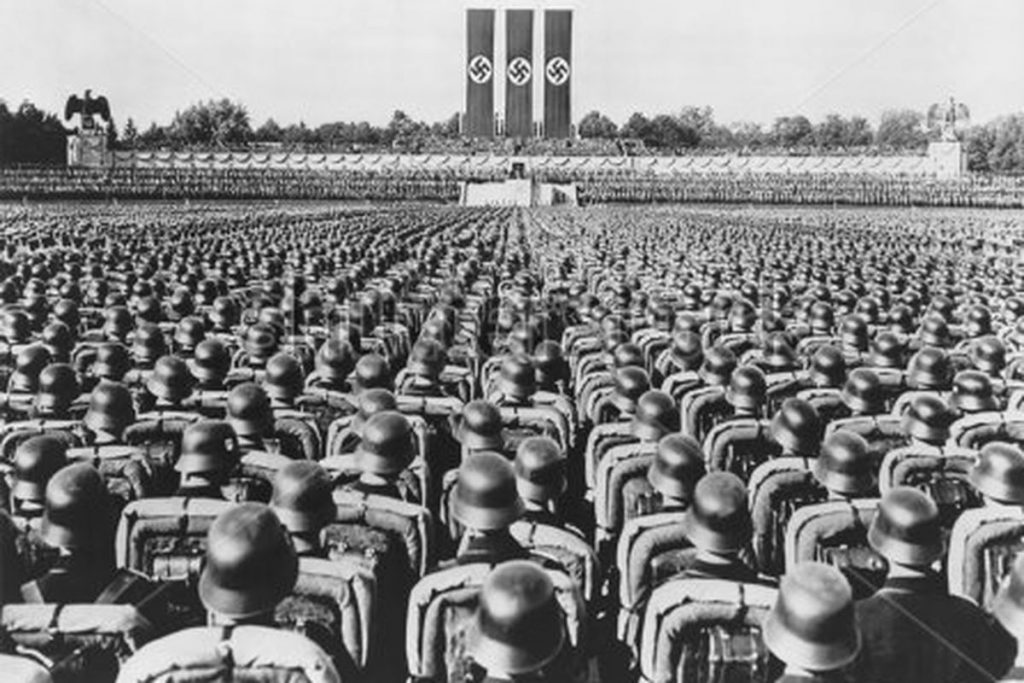It’s their strutting. That detestable image of the strutting that links them, the strutting and prancing Fascists and their swaggering and parading military cousins, up front for their conveniently concealed corporatist controllers.

A strutting and swaggering couple they are, Fascism and the entrenched class of war. Their distorted visions of gallantry and nation come so naturally to both. The spick and span generals, employers of mercenaries and killers, chin in, chest out, and their majors and their colonels (especially the generals in the offices and the majors in the tents), thick chests covered with ribbons and medals and rows of multicolored decorations — awarded for killing. And the political Fascists! Defiant chins thrust forward, hard fists clinched, swaggering and prancing and strutting across the stages of piazzas, nations and continents in support of the killing.
For God’s sakes let’s don’t waste time on the propaganda of “supporting our troops over there!” Or defense of America’s values! Or the future of our children! Or the war on terrorism! Let’s don’t waste words on that. As if in their strutting and blustering they had a monopoly on care for our sons! Let the generals and the industrial-military complex and our new administration (hopefully) support our boys “over there” in the only way that really counts — by bringing them home.
But here let’s zero in on strutting Fascism in its dreams of glory and on its corporate partners and their dreams of a New World Order. Let’s call a spade a spade. I have in mind the word Fascism that we progressive writers often use as an epithet. Or sprinkled here and there in our labels of proto-Fascist, crypto-Fascist, neo-Fascist and today, in Italy, post-Fascist. An old word whose essence, whose very quintessence, has remained largely the same while the word itself has acquired such negative connotations that Fascists themselves deny their heritage, as recently the neo-Mayor of Rome, the neo-Fascist Gianni Alemanno, who in an interview with the English press denied he was ever a Fascist, recalling the disciple Peter denying he ever knew his master, Jesus.
Since their emergence in Italy, Fascists have liked to claim that they, too, are of the Left. Specious claim. Bizarre conclusion. We have to keep in mind that that is a Fascist claim. It has little to do with social or political or even theoretical reality. That Fascism like Socialism was a mass movement by no means makes it Left. Historical Fascism in Italy and Nazism in Germany set out as mass movements because they were in political competition with leftist movements. As such Nazi-Fascism was obligated to appeal to the masses, to the collective, to that extent becoming social. In that sense Fascism began as a mass collectivist movement, but only up to the historical point when it mutated into the Corporatism that Mussolini claimed as its true name.
Once in power, Fascism then shows its true face: it allies with and mutates into Corporatism, becomes elitist and regiments the masses. In power it is no longer a collectivist movement. That Power of any shade or color often goes wrong is a truism. But that does not mean that all mass movements-systems-ideologies are the same. The fact is that Fascism and Nazism arose chiefly in opposition to Communism. Fascism in practice will always be of the Right, Socialism-Communism of the Left.
After the fall of Soviet Communism two decades ago, some European intellectuals and political scientists proclaimed the end of ideologies, that the terms Left and Right no longer made sense and were old-fashioned, that they were actually the same. This is dangerous speculation and a lie. The words for the two political poles were in vogue from the French Revolution up until the onset of the American counter-revolution not many years ago when American conservatives declared them politically incorrect. Though the Democratic and Republican parties in the United States contain qualities of both Left and Right, a little of this, a little of that — with the result that both parties are the same — no political movement with a genuine ideology is or can be both Left and Right, a negative which in turn confirms the validity of the dichotomy.
Until the French Revolution society was divided vertically, with Power at the top, which filtered down through the hierarchy to the voiceless peasant-slave. The great social division has always been between property holders — today’s capitalists — and the landless — today’s working class, or simply between the rich and the poor. The Revolution instituted a more democratic horizontal Left-Right division, intended to limit and control Power. Reaction is Power’s nostalgia for return to the old system, which is what happens in Fascism-Corporatism: return to a vertical society. Just as the property holders and the landless, today’s capitalists-corporations on one hand and workers on the other, so also Left and Right, are and always will be by definition in opposition.
Mussolini’s ignominious end. Fascism’s incarnation died for a moment but the fascist virus continued, since it lives off of capitalist ruling class dynamics.Right, or in this case Fascism, believes in the superiority of its cultural heritage and the past of nation, people, race and traditions, in defense of which it relies on militarism. An extreme right-winger rejects equality, wants as little change as possible, is skeptical about political systems and international rules and is committed to a society of hierarchy and meritocracy.
The Left, reformist or revolutionary, stands for emancipation from the past and for change. Yet it is nonsense that advocacy of change automatically places one on the Left. In the case of Italy, Fascism’s brief exploitation of the Futurist movement in the arts in order to execute its revolution did not make it Left. Fascism, too, wanted to remake society, but by glorifying and worshipping the past. In fact, a kind of Sicilianism — change everything so that nothing changes.
Though some attitudes, positions and values are interchangeable, there is a limit. War obviously belongs to the Right. War is a typically Fascist manifestation emerging from its worship of militarism and expansionism. War is no minor political slipup, as American Democrats should know by now. Historically, war is all determinant. War has already destroyed the foundations of the American republic and undermined American democracy itself. The position on war of America’s Democratic Party today is a Right position, as is its position on social justice. Right positions inevitably cause increased social injustice, social clash and war. Likewise the pro-war position of European Social Democracy at the outbreak of World War I led directly to its political decline, the birth of Fascism-Nazism, to the predominance on the Left of the Bolsheviks, and indirectly to the birth of Socialism in one country and Stalinism.
Norberto Bobbio (1909-2004), a major Italian political philosopher, determined that the major distinction between Left and Right is the relationship of each with equality. Though not every social-political view can be classified as Right or Left, as a rule Left tends toward everything that strives for equality among men; Right tends toward inequality. In practice the more one rejects equality, the more Right one is. Or, more forcefully, Right favors forms of the hierarchies dividing men. The distinction on the question of equality is clear, uncompromising and on target. It’s one or the other — Left or Right. They are not interchangeable. Despite Fascism’s claims that it, too, is “Socialist” and despite Hitler’s appropriation of the word in National Socialism, and despite Left’s frequent electoral claims that it, too, is middle of the road, both ideologies, if they are genuine, are one or the other. Neither Left nor Right can be middle of the road.
Some political philosophers in Europe and the USA describe the basic divisions between the Left and Right with the comfortable categories of Progressive and Conservative. In my opinion those common words are not satisfactory. Right can be progressive on certain limited themes, while the broad Left to achieve and maintain political power becomes conservative as seen in the Left of America’s Democratic Party or in much of contemporary European Socialism. To repeat, both Nazism and Stalinism used the word Socialist freely and in the end created parodies of socialist states.
Today, Left considers the Center a disguised Right; the Right believes the Center is a cover for the Left. In the political confusion of contemporary Italy, both the neo-Fascist Right and the Socialist Left have moved gradually toward Center positions. The Center, or the Third Way, is often a cover for one or the other positions. That Third Way is often labeled a “conservative revolution,” as if social ambivalence could prevail over genuine Left or genuine Right. In the long run, the Center also is obligated to assume positions reflecting either Left or Right.
So it is one or the other, Left or Right. Even though one does not eliminate the other, one or the other predominates in a given society in a given moment. Times change but the basic dichotomy remains.
The most blatant example of ignoring the Left-Right political reality is the USA, the world’s most powerful country controlled by a one-party system, which in effect ignores the words Left and Right. America’s Republican and Democratic parties stand shoulder-to-shoulder on the Right, bolstered by religious extremists, secret militias and the flag-waving false patriots. Though the Democratic and Republican parties in the United States contain a little of this, a little of that — with the result that both parties are practically the same — no political movement with a genuine ideology is and can be both Left and Right. Some positions and values can be exchanged and integrated in diverse systems, but there is a limit.
No one genuinely on the Left (in the Democratic Party, Liberals or Social Democrats) can defend Anglo-American conservatism or the liberalism-conservatism-Corporatism-Militarism-Fascism alliance. One forgets that there are limits as to what politics can accomplish. The open spaces the US political system leaves vacant have been occupied by the all-powerful, elitist, anti-human, militant and militaristic industrial-military complex of the modern corporatist state. In sum, the combination creates the authoritarian system. It is that extra-political vacuum (where there should be a Left!) which creates space for the populism and demagoguery of Fascism. America’s two interdependent parties have exchanged political and social values like merchandise. The result is that the one-party system based on the great euphemism of democracy — now a façade, fake and mendacious — stands as the banner and standard of the great American Counter-Revolution.
Historical Fascism
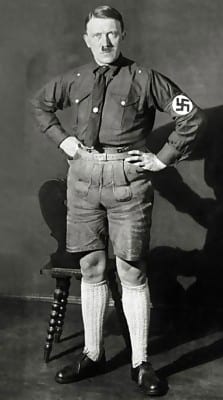
If one behaves like a swaggering Fascist, speaks like a super nationalistic Fascist, acts like a Fascist bully, he must be a Fascist. We feel a certain solace in just pronouncing the epithet, “fucking Fascists!”
Yet the word Fascism has not always been politically derogatory. Not by a long shot. Within a decade early last century, the word Fascism came to be applied to a cluster of similar nationalist-militaristic movements in Europe, the most important of which were the original Fascism in Italy and Nazism in Germany, or National Socialism. In a wave of revolutionary nationalism, Fascism first emerged in an Italy ravaged by World War I. The swaggering strutting nationalistic movement of Mussolinian Fascism had no precise forerunners from the 19th century, as did Socialism and Communism, but it was soon admired and imitated by like-minded movements across Europe and in the USA.
William Dudley Pelly’s Nazi-supported Silver Shirts organized in the 1930s in the town of Asheville, NC, where I grew up was the most influential, most violent, most anti-Semitic of native American Fascist organizations, with allegedly some 2 million members and with whom today’s Right still has ideological bonds. America’s Fascists favored Nazi Germany and Fascist Italy in WWII. Religion and intense hatred of minorities bond Christian Identity and right-wing extremists with the former Silver Shirt movement. TV evangelists of the likes of Pat Robertson and Jerry Falwell have followed the same format — hate of Communism, Jews, gays, abortion, welfare, unions — in favor of the corporate-clerical state.
With the rise of the power of corporations came also the rise of the modern military-police profession cast in a new role. As did former monarchs, modern corporations and their stockholders need the military-police control mechanism in order to ascertain that the populace never rises up in protest. Their marriage is the heart of Fascism. Fascism in practice is thus the protective shield for Corporatism. For every Corporate-Fascist state inevitably erects a police state to regulate and finally enslave its people. The most striking historical examples were Italy and Germany last century. Today, it is the USA and its proxy puppet governments around the world.
The term Fascism derives from the Italian fascio, or Latin fasces, in reference to the bundle of rods that symbolized the authority of the Republic of ancient Rome. The term was used occasionally in the late 19th century for new radical movements combining strong nationalism, aggressive activism and violence and “authoritarianism,” another term coined by early Italian Fascists, signs of which have reappeared today in contemporary Berlusconian Italy.
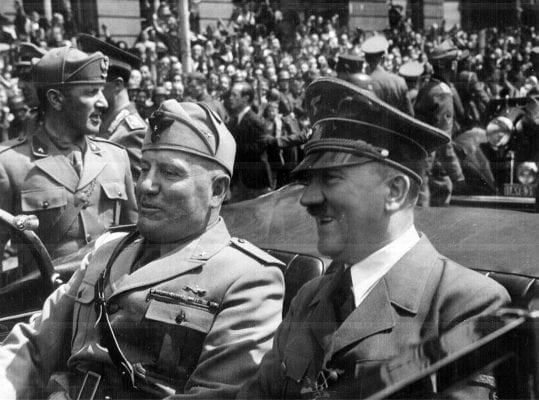
Revolutionary Italian nationalists after WWI used the word fascio for the movement that in 1921 became the Fascist Party. Wearing a black shirt, the color of Fascism, Benito Mussolini recruited a fascio di combattimento, or combat group. Mussolini did not found Italian Fascism but he insinuated himself into its leadership and became its supreme leader, Il Duce. His combat fasces and the drums of authoritarianism created an atmosphere in which Fascist dictatorship was wildly perceived as the only salvation of strife-ridden Italy, a strategy eerily echoed today in Berlusconian Italy. Mussolini became modern Europe’s first Fascist leader, Italy’s prime minister and dictator from 1922 to 1943.
In the widespread post-World War I disenchantment and in Europe, Mussolini’s revolutionary spirit and his Fascist model were contagious and spread over Europe and to the USA. Based on a corporatist and totalitarian vision of the state, Fascism then, as today, has considered itself a third way between capitalism and Socialism-Communism.
Benito Mussolini offered this authoritative definition of Fascism: “Fascism is a great mobilization of material and moral forces. What does it propose? We say the following without false modesty: To govern the nation. With what program? With a program necessary to guarantee the moral and material grandeur of the Italian people. Let’s speak clearly: It’s of no import if our concrete program is somewhat convergent with that of the Socialists as far as the technical, administrative and political reorganization of our country is concerned. We work for the moral and traditional values which Socialists neglect and despise. . . .”
Corporatism was so much the heart of Italian Fascism that Mussolini insisted that Fascism should in fact be called Corporatism because it is a merger of the nationalist-military state and corporate power. His words struck a chord in the hearts of European and American capitalists in the 1930s and ’40s, just as they still do today. For if one bothers to look, the traits of Fascism are highly visible in Corporatism. What are corporations anyway? Corporations are legally named persons, fictitious persons that have gained more rights than individual human beings.
By nature corporations are thirsty for power. They are insatiable. Growth and more power are their mottos. As corporations acquire more power, they and their lobbies come to control also the puppet government and thus the real people of flesh and blood whose rights cannot but deteriorate. The goals of corporations, their raison d’etre and the twin pillars of their existence, are growth and greater and greater profits. In the capitalist state the “government of the people” becomes a fiction and morphs into corporate rule. In that sense US liberalism has considerable overlap with Fascism. The word Corporatism fits well the social-political setup in the USA and most of Europe today and, in that sense, is an heir of Fascism.
Mussolini, I believe, would feel quite comfortable in the NATO-European Union-USA-European arena today. The merger of the military-industrial complex and the political world in the USA is the most contemporary example of the concept of Corporatism-Fascism. In their penetrating, pervasive and increasingly authoritarian interventions in socio-economic life, today’s governments in America and Europe are in fact examples of Fascism in action. Moreover, it should be noted here that while Fascism in its Mussolinian origins was nationalist, today it is global. Globalization is no less than Mussolini’s Fascism-Corporatism in action on a world scale.
It’s no wonder that from its inception Fascism violently opposed Socialism and Communism. Anti-Communism and anti-Socialism have been the US corporate-political policy since the rise of workers’ movements in the middle of the 19th century. The original Fascism itself was born in part as a reaction to the Russian Revolution, in part in opposition to the rise of the ideal of liberal democracy. From the start Fascism everywhere combined ideological aspects of the extreme Right such as nationalism, militarism, expansionism and meritocracy (the latter is much in vogue today in Berlusconian Italy) and idealist elements borrowed from workers’ movements such as the primacy of labor, social and unionist revolution. The very word Nazi derived from the name of Hitler’s National Socialist Party, reflecting its emergence from and support by the petty bourgeoisie. And still today, Italian neo-Fascists describe their movement as social and named their post-Mussolinian political party, the Italian Social Movement.
Antonio Gramsci, the political thinker, philosopher and co-founder of the Italian Communist Party, in an article, “Little Fascists” (Piccoli fascisti), in Ordine Nuovo, January 2, 1921, linked the Fascism of his time to the petty bourgeoisie, at the time called the shopkeepers’ class, perhaps closest to the American liberal upper middle classes today.
“In this its last political incarnation which is ‘fascism,’ the petty bourgeoisie has revealed its real nature as a servant of capitalism and landed property. But it has also shown that it is fundamentally incapable of playing any historic role: the people of monkeys fill the news, does not create history, leaves traces in the newspapers, does not offer materials for books. The petty bourgeoisie, after having ruined Parliament, is now ruining the bourgeois state: it substitutes private violence for the authority of law. . . .”
In one of Gramsci’s famous quotes Fascism was described as an attempt to resolve production and trade issues with “machines guns and revolver shots.”
“Productive forces have been ruined and wasted in the imperialistic war: twenty million men in the flower of youth and energy have been killed; the thousands of links that united world markets have been violently destroyed; the relations between countryside and city, between metropolises and colonies, have been turned upside down; the streams of emigration that periodically re-established unbalance between an excess of population and the potentiality of the means of production in single nations have been profoundly upset and no longer function normally. . . . Yet there exists a small layer of population in all countries — the petty and middle bourgeoisie — that believes it can resolve these gigantic problems with machine guns and revolver shots, and this small layer fuels fascism, supplies manpower to fascism.”
The roots of Fascism are European, linked to the birth of mass society after WWI, especially in those nations in transformation, which were conditioned by political and economic weakness as were Italy and Germany defeated in the Great War. Labeled by Thomas Mann the “moral sickness of Europe” of the epoch, Fascism found particularly fertile ground in Italy and Germany. Fascism is not based on any one class. It draws support from all. It is the result of wayward moral conscience and drunken decadence produced by the horrors of war and it affected most countries that participated in the conflict — that is much of the world.
Yet, as Gramsci noted, the petty bourgeoisie provided Fascism’s most ardent supporters. This relationship of Fascism-middle class is essential, central, in order to grasp the nature of Fascism at all latitudes. It was the common denominator between Italy and Germany. This relationship distinguishes Fascism from similar regimes and movements elsewhere which though often called Fascist are only marginally so. This relationship also explains the mass support Italian Fascism and German Nazism acquired, the reputation as mass movements, for regimes that in power could only develop based on a police state, terror and a monopoly of mass propaganda.
Fascism as Corporatism
There is some truth to the claim that liberalism created Fascism. The Italian petty bourgeoisie created Mussolinian Fascism and still today, 2008, the same petty bourgeoisie in Rome’s borgate, the vast poorer and workers’ districts, are the backbone of Italy’s neo-Fascism and Berlusconian populism. In Mussolini’s time, the wealthy upper classes abetted and encouraged Fascism’s emergence, confident that it could control it. To a certain extent and for a certain time it did. Until Fascism in power showed its true face and controlled the controllers. Yet Mussolini insisted on the name of Corporatism instead of Fascism. Today, capitalism is both partner and controller of American Corporate Fascism as were capitalists in Europe and the USA in the 1920s and ’30s.
Even a superficial analysis of the state created by the Corporate Fascism-middle class symbiosis of three-quarters of a century ago shows clear analogies with the American form of Corporatism today. Though not yet widely identified as such, Fascism is already in place in power in this great and powerful Corporatist state. American Corporatism has created the bases of its police state as Corporatism did in Fascist Italy and Nazi Germany. The state relies on terrorism to create the threat from external enemies created by the state itself. Hitler’s burning of the Reichstag in Berlin for which Communists were blamed was Nazi Germany’s Twin Towers. The American corporatist state uses establishment media and acquiescent intellectuals for its mass propaganda a la Goebbels to maintain the false consciousness and the Americanism image. The subservient media and compliant intellectuals serve to create the myths of the elusive American dream and the mythical American way of life of comfort and ease — in sum, Americanism — and to assure the consent of the masses in the interests of wealth, power, and privilege.
Fascism is thus a product of capitalist society, an anti-proletarian reaction to protect the social relations reigning in capitalist production. Fascism is the falange Italy’s Prime Minister Silvio Berlusconi speaks of today to break workers movements in the interests of capital. Mussolinian Fascism, and German Nazism organized the nation spiritually by intense radical demagogic propaganda, military build-up, the creation of a mass social base and centralized government. In a similar fashion, the Margaret Thatcher and Ronald Reagan governments of the 1980s marked the revival of the process of Corporatism, the crushing of any illusions of a welfare state in the USA and the weakening of the foundations of social democracy in Great Britain.
Once firmly in power Fascism always carries out a palace revolution in order to further regiment the masses while leaving capital free to dispose of plus value as it desires. In this sense, the corporate state crushes class struggle and guarantees the monopoly organization of capital. During the acme of his power in the early 1930s, Mussolini repeatedly claimed that within a few years all of Europe would be Fascist. Though I am little inclined to dwell on affinities between Mussolini and Lenin, still, in the 20th century the great ideological movements were in competition for the souls of the masses. Mussolini believed firmly in the fascistization of the world as Lenin did in world Socialist revolution. In that respect Fascism was counter-revolutionary and reactionary despite its claims that it was social and revolutionary.
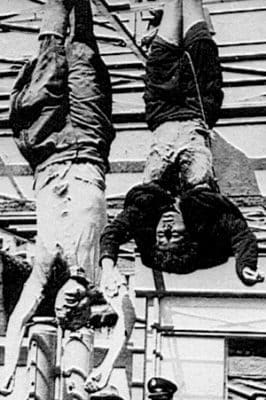
One question remains: the difference between Fascism and Nazism. Can one distinguish between them qualitatively, recognizing however the same essence in each? Or are they perhaps different movements also in essence? Mussolini believed they were different. Subsequent history has also differentiated between them. The Polish Pope John Paul II said at the end of his life that Nazism was the supreme evil of the century. Though history in general tends to consider Fascism a variation of other authoritarian regimes, one might add, closest to the USA today, I prefer to leave them together, wrapped in each other’s arms, one comforting the other.
In contrast to Socialism, both Fascism and Nazism were from the start extremely nationalistic, attempts to perpetuate the heredity of a people, a nation, a race. Socialism-Communism, despite its failures to live up to that promise, was internationalist by nature; in the long run Soviet Communism became nationalistic, even though that mutation came to be blamed—with much logic— on the capitalist encirclement. That encirclement was real, not a scarecrow as is terrorism and security today. It really happened. Fascism on the other hand goes far beyond traditional nationalism. It perceives of the nation not as the hereditary container of values but also as a future of power. For Fascism, history is not perceived as loyalty to values but as history’s continuing recreation over and over again, which requires for its fulfillment the crushing of anything standing in its way. Hitler himself recognized Italian Fascism as the first movement that fought against Marxism and Communism, in his view, from a non-reactionary point of view.
In the USA the choice of individualism and the privation of a solid and stable workers movement capable of political power in the name of social justice are dissonant with social development and social justice. In Europe the diverse histories of workers movements had close relationships and inter-connections with the rise of the nation states. Therefore, the flagrant divergence of the model of the federal state projected by the USA from that of Europe. Thus the pernicious halo around the now fictitious American dream and Americanism, which provide the permanent foundations for an enduring Corporatist-Fascist state.
Gaither Stewart is a veteran journalist, his dispatches on politics, literature, and culture, have been published (and translated) on many leading online and print venues.
Originally published in Greanville Post

